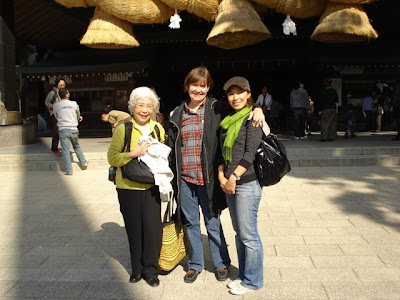

Today I went to Izumo Taisha at last.
The grand shrine of Izumo, also called Izumo no Oyashiro, is one of the oldest and most revered Shinto shrines of Japan.
There is a saying still that 8 million kami of Japan are gathering each year in the 10th month at Taisha. October therefore is called month without gods (kami-na-tsuki) only in Izumo month with gods (kami-ari tsuki).
So I obviously chose a good time to visit Shimane, or the Izumo of old.
The sun was shining brightly and I had a good briefing by Terazu-san who even gave me some small coins to use for the ritual at the shrine.
On the bus from Izumoshi to the shrine an elderly lady, Tomoko, from Hokkaido, a visitor as well, took good care that I would not miss the right stop. So it was natural and very pleasant too, that we visited the shrine together. Once we walked through the many huge torii in the pine woods which surround the sacred place we were joined by a young girl, Motoko, who to begin with helped out with English, when Tomoko was at a loss. The buildings appear in "taisha-zukuri", the oldest style of shrine architecture in Japan. I was impressed by the shimenawa of the haiden which supposedly measures 13 m in length and weighs tons. Having followed the purification as shown by Tomoko and prayed as instructed by Terazu-san, I had to buy an Omikuji as it was a book on those Oracles on a white paper which first drew my attention to Izumo. Tomoko and Motoko followed reluctantly. As I could not read it, I handed the little white piece of paper to Tomoko and for a while I heard only excited Oh’s then followed by a torrent of words. Omikuji are oracles telling your destiny, you can have a good or a bad fortune and in both cases people tie the little white papers to strings or trees in the sacred grounds, either to make them come true or to hope for the help oft he gods to prevent the misfortune. My destiny was obviously very fortunate and even better than Tomoko’s and Motoko‘s who were pleased as well. After ward when I went around the fenced in Main Hall (honden) and other attached buildings, all of them typically thatched with pine bark chippings, Tomoko took a rest and even Motoko looked out for me from time to time. This was not difficult as there were only a few Westerners among the visitors and I always returned faithfully.
At one time the honden must have been very impressive. Archaeological finds suggest that the original structure was placed on very high pillars, only accessible by very steep stairs.
We were more lucky and could watch a wedding ceremony at the second hall (kagura den) . Okuninushi-no-mikato to whom the shrine is dedicated is not only a god of agriculture but also the Shinhto deity of marriage. I was puzzled at first to see many people throwing ceaselessly coins up to the shimenawa.I only learnt later that for the lucky one whose coin does not fall down a wish comes true.












x.jpg)


